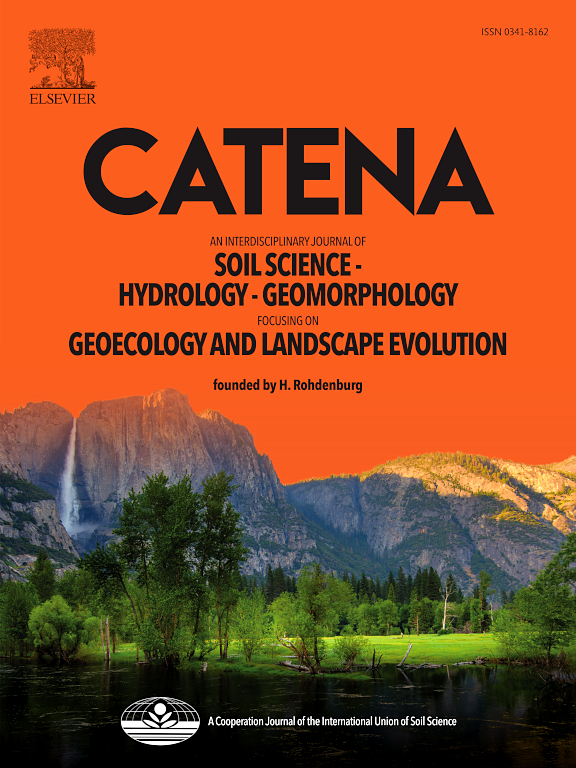Ecological barrier of the Tianshan Mountains controls agroecosystem multifunctionality through soil microbial processes
IF 5.7
1区 农林科学
Q1 GEOSCIENCES, MULTIDISCIPLINARY
引用次数: 0
Abstract
Ecosystem multifunctionality (EMF) is influenced by rhizosphere microorganisms, and understanding how they regulate EMF has been an intriguing process to date. Here, amplicon sequencing was employed to investigate the diversity, assembly processes, and co-occurrence networks of rhizosphere bacteria and fungi in the topsoil (0–20 cm) across eight cotton ecosystems on both sides of the Tianshan Mountains in Xinjiang. Multifunctionality indicators were calculated based on soil properties and cotton attributes. The results indicated that rhizosphere microorganisms exhibited distinct clustering patterns between the northern and southern regions, where bacterial α-diversity was lower in the northern region than in the southern region, while this trend was reversed for fungi. Soil total potassium, carbon-to-nitrogen ratio, and urease activity primarily regulated bacterial diversity, while pH and electrical conductivity predominantly influenced fungal diversity. Deterministic and stochastic processes dominated bacterial and fungal community assembly, respectively; the proportions of dispersal limitation were larger in the southern region than in the northern region, while the proportions of homogeneous selection were reversed. The complexity and stability of microbial co-occurrence networks were higher in the southern region than in the northern region, with higher average degree (bacteria: north/south, 19.231/29.399; fungi: north/south, 4.969/24.585) and network density (bacteria: north/south, 0.015/0.020; fungi: north/south, 0.019/0.072), and lower modularity (bacteria: north/south, 0.700/0.669; fungi: north/south, 0.732/0.567). In addition, climatic conditions were the primary factors directly affecting multifunctionality indicators, and rhizosphere bacterial diversity influenced EMF by positively regulating SMF and cotton growth characteristics. Collectively, our findings carry important ecological implications for sustaining ecosystem service functions and elucidating the relationships between the functional diversity of rhizosphere microorganisms and EMF under multifaceted environmental interactions.
天山生态屏障通过土壤微生物过程控制农业生态系统的多功能性
生态系统多功能性(EMF)受到根际微生物的影响,了解它们如何调节EMF一直是一个有趣的过程。利用扩增子测序技术,对新疆天山两侧8个棉花生态系统耕层(0 ~ 20 cm)根际细菌和真菌的多样性、组装过程和共生网络进行了研究。根据土壤性状和棉花性状计算多功能指标。结果表明,根际微生物在南北地区呈现明显的聚类模式,细菌α-多样性在北部地区低于南部地区,真菌则相反。土壤全钾、碳氮比和脲酶活性主要调节细菌多样性,而pH和电导率主要影响真菌多样性。确定性和随机过程分别主导了细菌和真菌群落的组装;南部地区的扩散限制比例大于北部地区,而同质选择比例相反。南部地区微生物共生网络的复杂性和稳定性高于北部地区,平均程度(细菌:北/南,19.231/29.399;真菌:北/南,4.969/24.585)和网络密度(细菌:北/南,0.015/0.020;真菌:北/南,0.019/0.072),模块化程度较低(细菌:北/南,0.700/0.669;真菌:北/南,0.732/0.567)。此外,气候条件是直接影响多功能性指标的主要因素,根际细菌多样性通过正向调节SMF和棉花生长特性来影响EMF。总的来说,我们的研究结果对维持生态系统服务功能和阐明在多方面环境相互作用下根际微生物功能多样性与EMF之间的关系具有重要的生态学意义。
本文章由计算机程序翻译,如有差异,请以英文原文为准。
求助全文
约1分钟内获得全文
求助全文
来源期刊

Catena
环境科学-地球科学综合
CiteScore
10.50
自引率
9.70%
发文量
816
审稿时长
54 days
期刊介绍:
Catena publishes papers describing original field and laboratory investigations and reviews on geoecology and landscape evolution with emphasis on interdisciplinary aspects of soil science, hydrology and geomorphology. It aims to disseminate new knowledge and foster better understanding of the physical environment, of evolutionary sequences that have resulted in past and current landscapes, and of the natural processes that are likely to determine the fate of our terrestrial environment.
Papers within any one of the above topics are welcome provided they are of sufficiently wide interest and relevance.
 求助内容:
求助内容: 应助结果提醒方式:
应助结果提醒方式:


